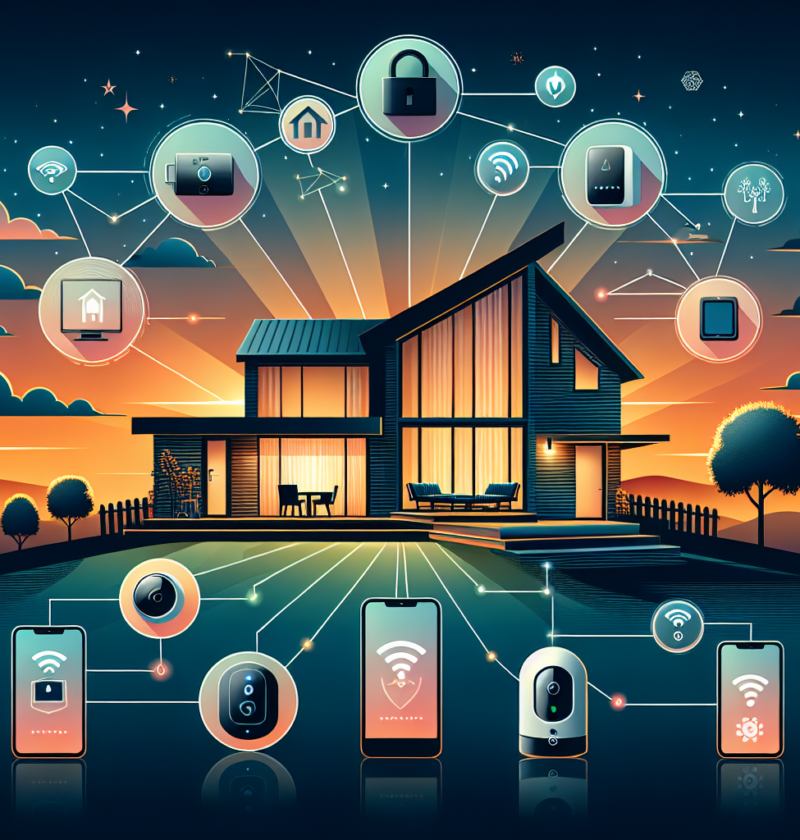Introduction to Smart Home Security
The evolution of smart home security devices has transformed the way we protect our homes. From traditional locks and alarms to advanced systems integrated with artificial intelligence and the Internet of Things (IoT), these innovations offer unparalleled convenience and safety. This article delves into the latest advancements in smart home security devices, highlighting key technologies, benefits, and future trends.
Historical Context of Home Security
Home security has always been a priority for homeowners. Early systems relied on basic mechanisms like deadbolts and rudimentary alarm systems. Over time, advancements introduced features such as motion detectors, surveillance cameras, and remote monitoring. The advent of digital technology and connectivity has further revolutionized home security, enabling smarter and more responsive solutions.
AI and Machine Learning in Home Security
Artificial Intelligence (AI) and machine learning are at the forefront of modern smart home security devices. These technologies enable systems to learn from patterns, recognize anomalies, and make intelligent decisions.
Enhanced Threat Detection
AI-powered security cameras can differentiate between humans, animals, and inanimate objects, reducing false alarms and ensuring that real threats are promptly identified. Machine learning algorithms analyze behavior patterns to detect suspicious activities, enhancing overall security effectiveness.
Adaptive Security Systems
Smart security systems equipped with AI can adapt to the homeowner’s routines. For instance, lights and alarms can automatically adjust based on the time of day or when the system detects unusual activity, providing a customized security experience.
Advanced Sensors and Detection Technologies
Modern smart home security devices incorporate a variety of sensors that significantly improve detection capabilities.
Biometric Sensors
Biometric sensors, such as fingerprint and facial recognition, offer high levels of security by ensuring that only authorized individuals can access certain areas or control systems. These sensors add an additional layer of protection beyond traditional password-based systems.
Environmental Sensors
Environmental sensors detect changes in conditions like temperature, humidity, and air quality, which can indicate potential security threats such as fires or gas leaks. Integrating these sensors into security systems enhances overall home safety.
Integration with IoT and Other Devices
The integration of smart home security devices with other IoT devices creates a cohesive and efficient home ecosystem.
Unified Control Platforms
Platforms like Amazon Alexa, Google Home, and Apple HomeKit allow homeowners to control their security systems alongside other smart devices using a single interface. This seamless integration simplifies managing multiple systems and enhances user experience.
Smart Locks and Access Control
Smart locks can be controlled remotely, allowing homeowners to lock or unlock doors using smartphones. Additionally, these locks can grant temporary access to visitors or service providers, ensuring security without compromising convenience.
Facial and Biometric Recognition
Facial and biometric recognition technologies have revolutionized access control and surveillance in smart homes.
Enhanced Surveillance
Security cameras with facial recognition can identify individuals, distinguishing between family members, friends, and potential intruders. This feature provides real-time alerts and enables homeowners to monitor who is entering and leaving their property.
Personalized Access
Biometric systems ensure that only authorized users can access specific areas of the home. This level of personalization enhances security and prevents unauthorized access effectively.
Remote Monitoring and Control
One of the significant benefits of smart home security devices is the ability to monitor and control systems remotely.
Mobile Applications
Dedicated mobile applications allow homeowners to view live camera feeds, receive alerts, and control security settings from anywhere in the world. This remote access provides peace of mind, knowing that the home can be monitored even when away.
Automated Alerts
Smart security systems can send instant notifications to homeowners’ smartphones in case of detected threats, enabling swift responses. These alerts can include video footage, location data, and recommended actions.
Predictive Analytics and Preventive Measures
Predictive analytics use data to forecast potential security issues before they occur.
Risk Assessment
By analyzing patterns and historical data, smart security systems can assess the risk levels for different scenarios. This analysis helps in implementing preventive measures, such as adjusting sensor sensitivity or deploying additional security resources when necessary.
Maintenance and Updates
Predictive analytics also assist in maintaining the security systems by forecasting maintenance needs. Regular updates and proactive maintenance ensure that the devices function optimally and are protected against emerging threats.
Future Predictions in Smart Home Security
The future of smart home security is poised for significant advancements driven by technological innovations.
Integration with Smart Cities
As smart cities develop, home security systems will integrate with broader urban infrastructure. This integration will enable sharing of information between home devices and city services, enhancing overall security and emergency response capabilities.
Enhanced AI Capabilities
Future AI developments will provide even more sophisticated threat detection and response mechanisms. Systems will become more intuitive, understanding complex behaviors and predicting potential security breaches before they happen.
Comparisons of Different Technologies
Understanding the strengths and weaknesses of various smart home security technologies is essential for making informed decisions.
AI-Powered Cameras vs. Traditional Surveillance
AI-powered cameras offer superior threat detection and reduced false alarms compared to traditional surveillance systems. While traditional cameras provide basic monitoring, AI enhances functionality by interpreting data intelligently.
Smart Locks vs. Conventional Locks
Smart locks offer remote access control and integration with other smart devices, providing greater flexibility and security. Conventional locks, while reliable, lack the advanced features and convenience of smart alternatives.
Pros and Cons of Advanced Smart Home Security Devices
Like any technology, smart home security devices come with their own set of advantages and disadvantages.
Pros
- Enhanced Security: Advanced features provide higher levels of protection.
- Convenience: Remote access and automation simplify home management.
- Customization: Systems can be tailored to fit specific needs and preferences.
- Integration: Easy integration with other smart devices creates a unified ecosystem.
Cons
- Cost: Advanced systems can be more expensive upfront.
- Privacy Concerns: Increased data collection raises privacy issues.
- Dependency on Technology: Reliance on internet connectivity and software can lead to vulnerabilities.
- Complexity: Installation and management may require technical expertise.
Real-World Examples and Statistics
Real-world applications and data highlight the effectiveness of advanced smart home security devices.
Case Study: AI-Powered Surveillance in Suburban Homes
A study conducted in suburban areas revealed that homes equipped with AI-powered surveillance systems experienced a 30% reduction in break-ins compared to those with traditional security measures. The ability to distinguish between legitimate threats and non-threatening activities significantly contributed to this decline.
Statistics on Smart Home Security Adoption
According to recent surveys, over 60% of homeowners are adopting smart home security devices, with expectations of continued growth as technology advances. The market is projected to reach $74 billion by 2025, driven by increasing awareness and technological improvements.
Expert Insights
Industry experts emphasize the growing importance of smart home security in today’s connected world.
“The integration of AI and IoT in home security is a game-changer. It not only enhances protection but also provides homeowners with valuable insights and control over their security systems,” says Dr. Emily Chen, a leading cybersecurity expert.
“As smart homes become more prevalent, the demand for advanced security solutions will continue to rise. Future innovations will focus on making these systems more intuitive and user-friendly,” adds Michael Roberts, a tech industry analyst.
Cultural Impacts of Smart Home Security
The widespread adoption of smart home security devices has broader cultural implications, influencing how people perceive privacy, safety, and technology in their daily lives.
Changing Privacy Norms
With increased data collection and surveillance capabilities, there is an ongoing debate about privacy. Balancing security needs with privacy rights is becoming a critical consideration for both consumers and manufacturers.
Empowering Homeowners
Smart home security devices empower homeowners by giving them greater control over their safety. This empowerment fosters a sense of security and confidence, contributing to overall well-being.
Conclusion
The advancements in smart home security devices represent a significant leap forward in protecting homes and enhancing the quality of life for homeowners. With the integration of AI, enhanced sensors, and seamless connectivity, these systems offer robust security solutions tailored to modern needs. As technology continues to evolve, the future of smart home security promises even more innovative and effective ways to safeguard our homes.

